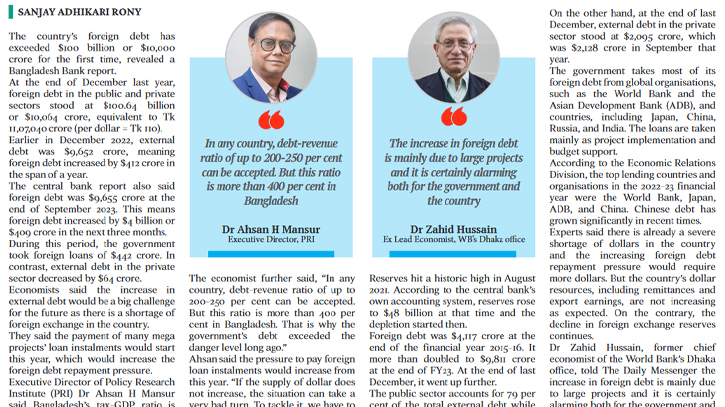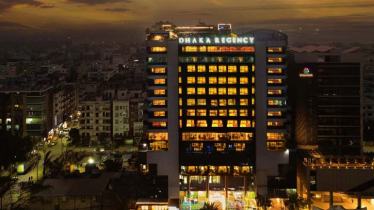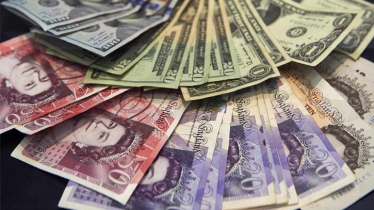
Photo : Messenger
The country’s foreign debt has exceeded $100 billion or $10,000 crore for the first time, revealed a Bangladesh Bank report. At the end of December last year, foreign debt in the public and private sectors stood at $100.64 billion or $10,064 crore, equivalent to Tk 11,07,040 crore (per dollar = Tk 110).
Earlier in December 2022, external debt was $9,652 crore, meaning foreign debt increased by $412 crore in the span of a year.
The central bank report also said foreign debt was $9,655 crore at the end of September 2023. This means foreign debt increased by $4 billion or $409 crore in the next three months.
During this period, the government took foreign loans of $442 crore. In contrast, external debt in the private sector decreased by $64 crore.
Economists said the increase in external debt would be a big challenge for the future as there is a shortage of foreign exchange in the country.
They said the payment of many mega projects’ loan instalments would start this year, which would increase the foreign debt repayment pressure.
Executive Director of Policy Research Institute (PRI) Dr Ahsan H Mansur said Bangladesh’s tax-GDP ratio is only 8 per cent, which means the government is unable to repay the debt with its own income.
“Therefore, there is no benefit in calculating the ratio of debt to GDP here. The ratio of debt in Bangladesh should be compared to the revenue of the government,” he said.
The economist further said, “In any country, debt-revenue ratio of up to 200-250 per cent can be accepted. But this ratio is more than 400 per cent in Bangladesh. That is why the government’s debt exceeded the danger level long ago.”
Ahsan said the pressure to pay foreign loan instalments would increase from this year. “If the supply of dollar does not increase, the situation can take a very bad turn. To tackle it, we have to stop taking supplier credit from China and Russia.”
The Bangladesh Bank data shows the country’s reserves were $19.99 billion on March 20. However, according to the International Monetary Fund (IMF), Bangladesh’s net reserves are now around $17 billion.
Reserves hit a historic high in August 2021. According to the central bank’s own accounting system, reserves rose to $48 billion at that time and the depletion started then.
Foreign debt was $4,117 crore at the end of the financial year 2015-16. It more than doubled to $9,811 crore at the end of FY23. At the end of last December, it went up further.
The public sector accounts for 79 per cent of the total external debt while the private one holds the remaining 21 per cent. At the end of last December, external debt in the public sector stood at $7,969 crore, which was $7,527 crore three months prior.
That is, in the last three months of 2023, foreign debt in the public sector increased by 5.87 per cent. On the other hand, at the end of last December, external debt in the private sector stood at $2,095 crore, which was $2,128 crore in September that year.
The government takes most of its foreign debt from global organisations, such as the World Bank and the Asian Development Bank (ADB), and countries, including Japan, China, Russia, and India. The loans are taken mainly as project implementation and budget support.
According to the Economic Relations Division, the top lending countries and organisations in the 2022-23 financial year were the World Bank, Japan, ADB, and China. Chinese debt has grown significantly in recent times.
Experts said there is already a severe shortage of dollars in the country and the increasing foreign debt repayment pressure would require more dollars. But the country’s dollar resources, including remittances and export earnings, are not increasing as expected. On the contrary, the decline in foreign exchange reserves continues.
Dr Zahid Hussain, former chief economist of the World Bank’s Dhaka office, told The Daily Messenger the increase in foreign debt is mainly due to large projects and it is certainly alarming both for the government and the country.
“Also, several loans and interests will have to be paid from this year, which will create additional pressure on the dollar reserve. To deal with it, the reserve has to be increased in any way possible.”
The government is implementing several big projects with foreign funding. These include Rooppur nuclear power plant, Padma Bridge rail link, metro rail (line-6), third terminal of Hazrat Shahjalal International
Airport, Karnaphuli tunnel, Matarbari coal power plant, Chattogram-Cox's Bazar rail line, etc.
According to the final report of the 2022 population and housing census, the current population of the country is 16.98 crore. Accordingly, at the end of last December, per capita foreign debt stood at $592 (about Tk 65,000).
However, per capita foreign debt was $574 last June. Eight years ago, it was just over $257.
Messenger/Disha








